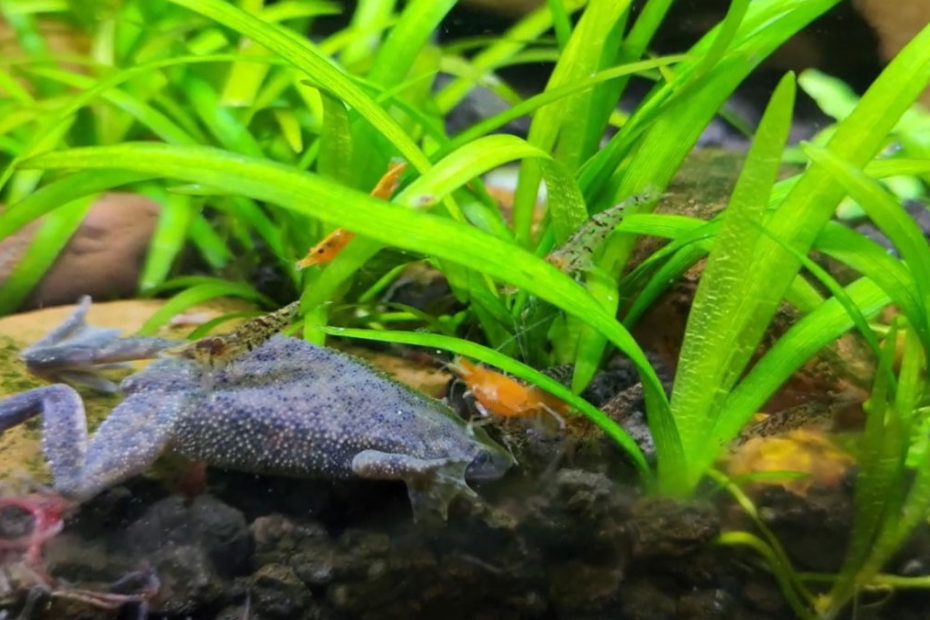The aquatic world is a fascinating place, full of diverse and colorful creatures. These include the African dwarf frog and shrimp. Both of these are popular choices for aquarists due to their characteristics and low-maintenance care.
But do they get along? The African dwarf frog and shrimp can coexist harmoniously in the same aquarium under the right conditions. Both species have specific requirements that need to be met to ensure their well-being.
In this article, we will explore the compatibility of these species and uncover whether they truly get along.
Overview of African Dwarf Frogs and Shrimp
The African dwarf frog and shrimp are two unique aquatic species that have become increasingly popular in the realm of pet keeping. Let’s get through the overview of both species first.
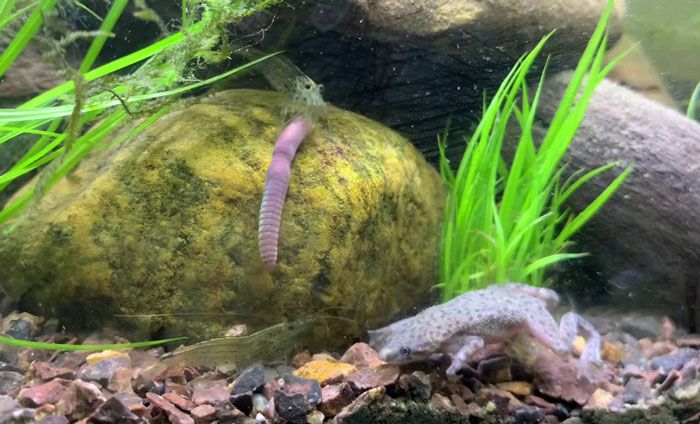
African Dwarf Frogs:
Here are the overviews of African Dwarf frogs to understand their nature.
Appearance:
- Size: Adult African Dwarf Frogs typically grow to around 1.5 to 2.5 inches (3.8 to 6.4 cm) in length.
Habitat:
- Natural Habitat: African Dwarf Frogs are native to slow-moving rivers and streams in Central Africa.
- Tank Requirements: They are aquatic and require a fully aquatic setup. A tank size of at least 5 to 10 gallons is recommended.

Behavior:
- Social Behavior: Generally peaceful and social, they are best kept in groups.
- Nocturnal: African Dwarf Frogs are nocturnal, meaning they are more active during the night.
Diet:
- Carnivorous: They eat a carnivorous diet, preferring live or frozen foods like bloodworms, brine shrimp, and small aquatic invertebrates.
Care Considerations:
- Temperature: They prefer slightly cooler water temperatures, ideally between 68-78°F (20-26°C).
- Hiding Spots: Provide hiding spots and gentle filtration, as strong currents may stress them.
Shrimp (Commonly Dwarf Shrimp, e.g., Cherry Shrimp)
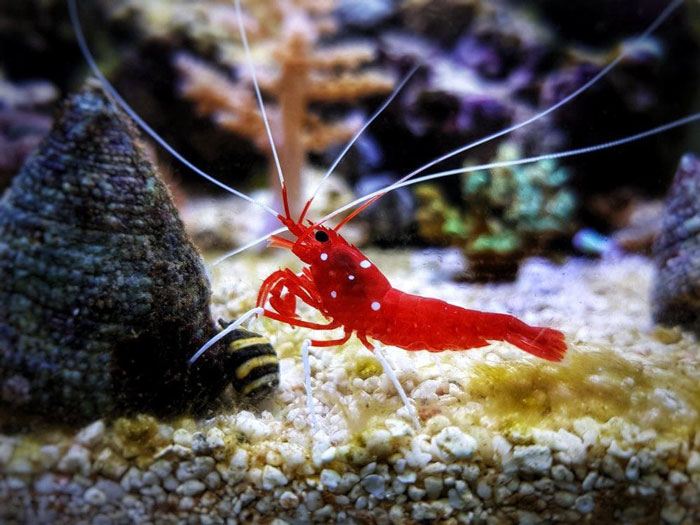
Here are overviews of shrimps to help you understand their nature.
Appearance:
- Size: Varying by species, but common dwarf shrimp like cherry shrimp are usually around 1 to 1.5 inches (2.5 to 3.8 cm) long.
Habitat:
- Natural Habitat: Shrimp, particularly dwarf shrimp, are found in freshwater habitats worldwide.
- Tank Requirements: They thrive in planted tanks with hiding places and a suitable substrate.
Behavior:
- Social Behavior: Generally peaceful and can be kept in groups. They are known for their scavenging behavior.
- Molting: Shrimp molt periodically to grow, and the exoskeleton is left behind.
Diet:
- Omnivorous: Shrimp are omnivores, feeding on algae, detritus, and small food particles. They benefit from a varied diet, including specialized shrimp pellets, algae wafers, and blanched vegetables.

Care Considerations:
- Temperature: Most dwarf shrimp species prefer a temperature range of 70-78°F (21-26°C).
- Water Quality: Shrimp are sensitive to changes in water parameters, so regular water testing and maintenance are crucial.
- Compatibility: Some fish may prey on shrimp, so choose tank mates carefully.
African Dwarf Frog and Shrimp: Do They Get Along?
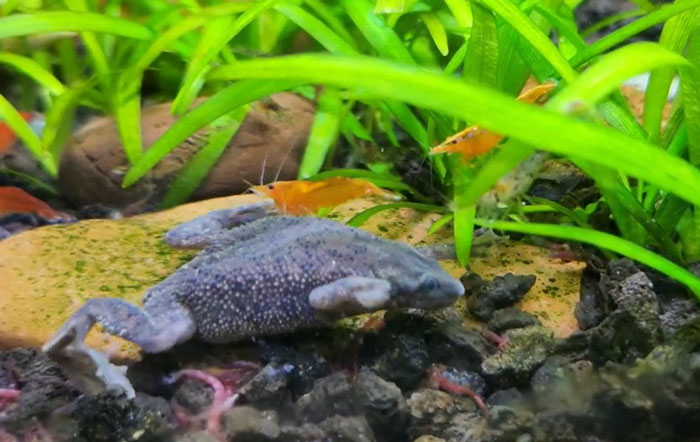
ADFs and shrimp can actually make great tank mates with the right conditions. It’s crucial to choose the right species of shrimp to cohabitate with your ADF. Certain types of shrimp, like cherry or ghost shrimp, can thrive alongside your ADFs. Here are some considerations for getting along:
General Compatibility:
- Tank Size: A minimum tank size of 10 gallons is recommended to provide ample space and reduce the risk of territorial disputes.
- Feeding: ADFs are carnivorous but may not see shrimp as food if they are well-fed. Offering a varied diet to the ADFs can reduce the likelihood of them preying on shrimp. Shrimp can eat a variety of foods, including algae wafers, blanched vegetables, and specially formulated shrimp pellets.
- Hiding Places: Provide ample hiding spots for shrimp. Dense vegetation, caves, and hiding spots can help shrimp feel secure, especially during molting, which is a vulnerable time.
- Peaceful Nature: ADFs are generally peaceful and may not actively pursue or harass shrimp. On the other hand, shrimps are peaceful creatures.
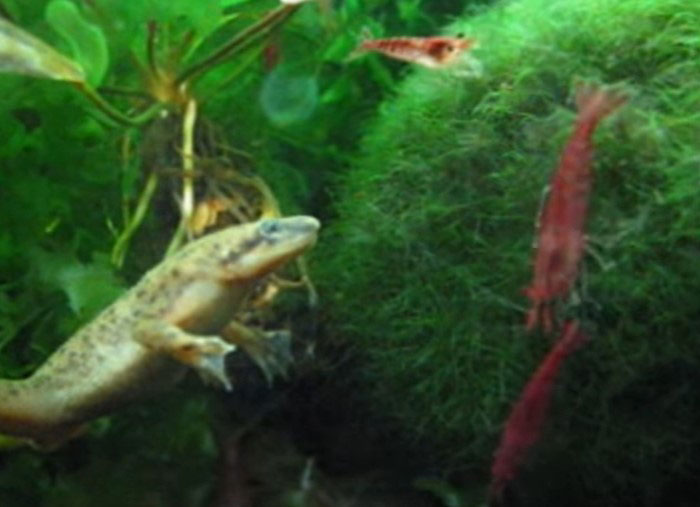
Monitoring and Adjustments:
- Observation: Regularly observe the interactions between ADFs and shrimp. Pay attention to any signs of stress.
- Feeding Strategies: Feed the ADFs separately from the shrimp to minimize competition during feeding times.
- Tank Setup: Ensure the tank is well-planted and has hiding places for shrimp. This can help create a more natural and secure environment.
Potential Challenges and How to Address Them
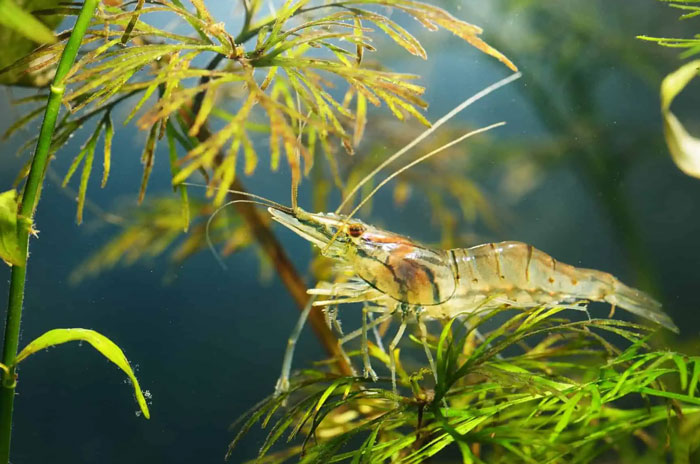
Here are potential challenges associated with keeping African Dwarf Frogs and shrimp together in an aquarium. Along with suggestions on how to address them:
Size Discrepancy
- Challenge: Adult ADFs are larger than most dwarf shrimp, posing a risk of accidental injury during activities like feeding or exploration.
- Address: Provide hiding spots and structures that are accessible to shrimp but too small for ADFs. This helps shrimp find refuge when needed.
Feeding Competition
- Challenge: ADFs might outcompete shrimp for food, impacting the shrimp’s nutritional intake.
- Address: Feed ADFs and shrimp separately. Use sinking pellets or target feed ADFs to minimize competition during mealtime. Ensure a well-balanced diet for both species.
Mating Disturbance
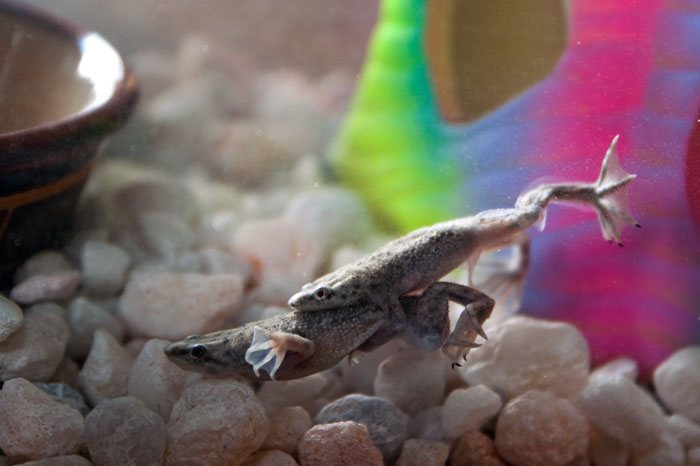
- Challenge: During mating behaviors, ADFs may become more active, potentially disturbing or stressing shrimp.
- Address: Provide hiding places and vegetation for shrimp. Observe ADF mating behavior and intervene if necessary by providing more hiding spots during mating periods.
Aggressive or Curious Behavior
- Challenge: Individual ADFs may exhibit varying levels of curiosity or even aggression towards shrimp.
- Address: Monitor their interactions closely. If aggression is observed, consider providing additional hiding spaces or separating the individuals temporarily.
Molting Vulnerability
- Challenge: Shrimp are vulnerable during molting, and ADFs may be attracted to the molting process.
- Address: Ensure a well-structured tank with hiding spots for molting shrimp. If necessary, create a molting box using mesh or a dedicated area where shrimp can molt without disturbance.
Water Quality Sensitivity
- Challenge: Both ADFs and shrimp are sensitive to changes in water quality.
- Address: Maintain stable water parameters, conduct regular water changes, and avoid sudden fluctuations in temperature. Test water regularly to ensure optimal conditions.
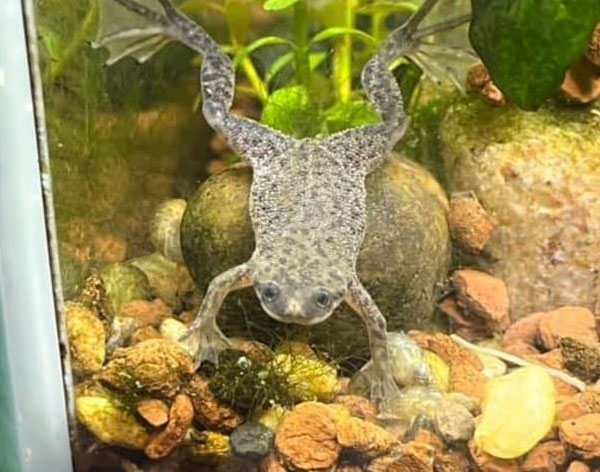
Observation and Adaptation
- Challenge: Individual personalities and behaviors vary among ADFs and shrimp.
- Address: Regularly observe their interactions. If any issues arise, be prepared to adapt the tank setup, provide more hiding spaces, or consider temporary separation.
Separation if Necessary
- Challenge: Persistent issues may require separating ADFs and shrimp.
- Address: If conflicts persist, consider providing separate tanks for ADFs and shrimp to ensure the well-being of both species.
FAQs
Here, we attached some common questions that may help you with keeping ADFs and shrimps together.
Gradually introduce new animals to your tank by floating their bags in the water for about 15-20 minutes before releasing them into the tank.
They can live with peaceful fish species that won’t harm or compete with them for food.
Yes, shrimp can often be kept with peaceful community fish that won’t harm them.
Smooth gravel or sand is ideal to prevent injury to the frogs’ delicate skin.
Conclusion
African dwarf frogs and shrimp can coexist harmoniously in the same aquarium, provided that the tank is properly set up and maintained. Both species are peaceful and generally non-aggressive towards each other, making them suitable tank mates for a community setup.
However, it is essential to ensure that the tank has plenty of hiding spaces and plants to create separate territories for each species. Regular monitoring of their behavior and feeding habits is also crucial to ensure their well-being. By following these guidelines, hobbyists can enjoy the delightful sight of these fascinating aquatic creatures living in harmony together in their tanks.

Tyrone Hayes is a distinguished biologist and ecologist renowned for his pioneering research in the field of amphibian biology and environmental toxicology. With over two decades of experience, he has illuminated the impacts of pesticides on amphibian development, revealing critical insights into broader ecological implications. Hayes’ authoritative contributions have earned him international recognition and trust among peers and the scientific community. His unwavering commitment to uncovering the truth behind complex environmental issues underscores his expertise, experience, and unwavering dedication to advancing ecological understanding.
